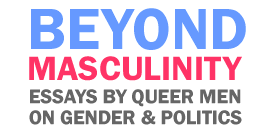

|
|

EXPOSING MASCULINITIES:
My Journey as a Queer Artist
|
 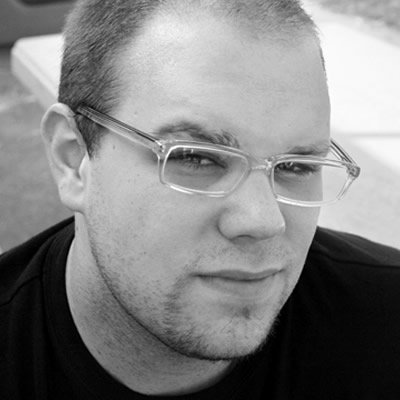
Sean Gyshen Fennell
|
By Sean Gyshen Fennell
Sean Gyshen Fennell is queer artist and activist originally from the Pacific Northwest. He attended Willamette University in Salem, Oregon and recently completed his graduate work at Washington University in St. Louis, Sam Fox School of Design and Visual Arts. Fennell is currently living in Denver, Colorado and teaching at the University of Denver, School of Art. |

|
PREVIEW MP3 RECORDING:
This text will be replaced by the flash music player.
|
|
|

his
essay chronicles my experience as a young queer artist. The narrative of what
follows reflects my creative process; it begins by speaking intellectually about
my reasons for making art and begins to become more personal as the work
develops. I conclude by discussing some of the artists and theorists that have
guided me through this creative process. While my works do not always have a
common aesthetic, they are interconnected, and the linear form of this essay
reveals the connections between the various pieces and the momentum of their
progression.
 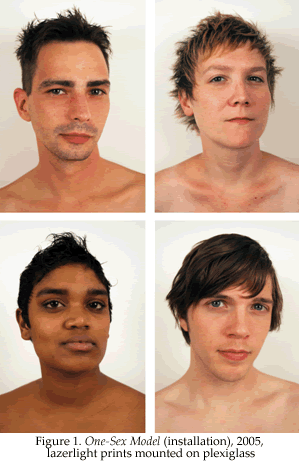 I am fascinated by
the actual nature of gender and investigate how it relates to ideas surrounding
self-representation. This prompted my, “One-Sex Models.” In the project I
attempted to find and photograph people who I felt were, to varying degrees,
existing outside gender norms. I did not want every model to be completely
androgynous but to have an element, through either physical structure, gaze or
pose, of gender ambiguity; I wanted to blur the categories rather than create a
new one. I chose to photograph each individual on a white background with a soft
but revealing light to give a stark, yet glamorous aesthetic to the work in
order to call attention to and explore the personal androgyny of the models. The
title “One-Sex Models” was meant to reference the notion of gender as a
continuum rather than a distinct categorization. I am fascinated by
the actual nature of gender and investigate how it relates to ideas surrounding
self-representation. This prompted my, “One-Sex Models.” In the project I
attempted to find and photograph people who I felt were, to varying degrees,
existing outside gender norms. I did not want every model to be completely
androgynous but to have an element, through either physical structure, gaze or
pose, of gender ambiguity; I wanted to blur the categories rather than create a
new one. I chose to photograph each individual on a white background with a soft
but revealing light to give a stark, yet glamorous aesthetic to the work in
order to call attention to and explore the personal androgyny of the models. The
title “One-Sex Models” was meant to reference the notion of gender as a
continuum rather than a distinct categorization. [1]
I found that by questioning the validity of gender I am also, and perhaps more
effectively, addressing the validity of sexuality.
 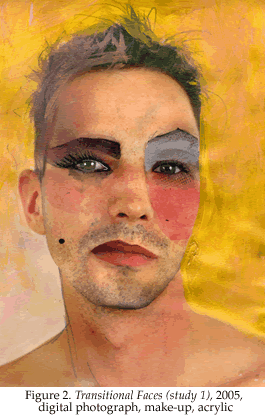 While creating “One-Sex Models” I was also working with some of the same images
in an aesthetically and conceptually different fashion to create
“Transitional-Faces.” This work explores externalized psychological states of
how some queer men explore gender. From firsthand experience and observations in
the queer community such exploration can take many forms ranging from drag to
hyper-masculinity. I chose to investigate the effeminate side of this
exploration, which mimics my own experience. I worked with the most “masculine”
of the images in order to give the images more gender range and conflict. To
achieve this effect I used paint and make-up on the surface of the images to put
the faces into tumultuous states of drag. While creating “One-Sex Models” I was also working with some of the same images
in an aesthetically and conceptually different fashion to create
“Transitional-Faces.” This work explores externalized psychological states of
how some queer men explore gender. From firsthand experience and observations in
the queer community such exploration can take many forms ranging from drag to
hyper-masculinity. I chose to investigate the effeminate side of this
exploration, which mimics my own experience. I worked with the most “masculine”
of the images in order to give the images more gender range and conflict. To
achieve this effect I used paint and make-up on the surface of the images to put
the faces into tumultuous states of drag.
Though aesthetically disparate both “One-Sex Models” and “Transitional Faces”
were created during the same time and used the same models. These works revealed
an interesting dynamic in my art: the psychological state creating
self-representation. This realization would not surface again until “Sewing the
Façade” and “Veiled,” which will be discussed further in the paper.
 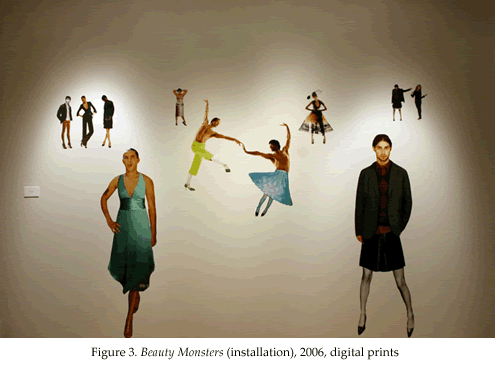 After the previous projects I began to investigate the various sources that may
inform ideas of self-representation to create “Beauty Monsters.” I became
particularly interested in the sources that directly depicted the notions of
hyper-beauty and body: fashion, fitness and porn magazines. I began obsessively
consuming and cutting up these magazines and would then spend hours piecing
together various disembodied parts to create grotesque figures out of idealized
gendered forms. I took great care when constructing these images to make them as
visually seamless as possible to heighten the work’s plausibility. These figures
were then scanned and printed in various scales from life-size to the
approximate size they would have originally been in a magazine. In the final
presentation, they were pasted to a gallery wall to appear as if an army of
Beauty Monsters was about to march into the space of the viewer. Among my
constructed figures I included one image that was directly scanned from the
magazine. The inclusion of this figure both highlighted the ridiculousness of
fashion images and made my constructions more believable. The intent of “Beauty
Monsters,” beyond an investigation of these sources, is to again provide visual
depictions of a queer gender continuum. In this way “Beauty Monsters” is
conceptually similar to “One-Sex Models.” After the previous projects I began to investigate the various sources that may
inform ideas of self-representation to create “Beauty Monsters.” I became
particularly interested in the sources that directly depicted the notions of
hyper-beauty and body: fashion, fitness and porn magazines. I began obsessively
consuming and cutting up these magazines and would then spend hours piecing
together various disembodied parts to create grotesque figures out of idealized
gendered forms. I took great care when constructing these images to make them as
visually seamless as possible to heighten the work’s plausibility. These figures
were then scanned and printed in various scales from life-size to the
approximate size they would have originally been in a magazine. In the final
presentation, they were pasted to a gallery wall to appear as if an army of
Beauty Monsters was about to march into the space of the viewer. Among my
constructed figures I included one image that was directly scanned from the
magazine. The inclusion of this figure both highlighted the ridiculousness of
fashion images and made my constructions more believable. The intent of “Beauty
Monsters,” beyond an investigation of these sources, is to again provide visual
depictions of a queer gender continuum. In this way “Beauty Monsters” is
conceptually similar to “One-Sex Models.”
 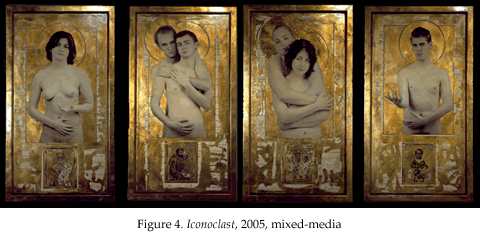 While working with ideas surrounding gender, a series I had created previously,
titled “Iconoclast” began to receive some controversial press. While working with ideas surrounding gender, a series I had created previously,
titled “Iconoclast” began to receive some controversial press. [2]
This was the result of some conservative activists objecting to my work being
publicly placed at my undergraduate university. This caused them to photograph my
work and appeal to several conservative media personalities. Lars Larson, a
conservative radio talk show host, picked up the story. I was notified by some
of my friends in Oregon and subsequently called The Lars Larson Show and
was interviewed (see Appendix 1, "Interview Transcript").
After this I made my own appeal to the liberal press and was published in The
Advocate and picked-up by other small Oregon-based newspapers. Through being
in The Advocate, I was contacted by members of the Catholic gay
community. This was around the time that Pope John Paul II died and Pope
Benedict XVI was appointed. His appointment is the source of turmoil amongst gay
Catholics, especially after the Church issued a new document on the church’s
view on homosexuality. I could not resist making a documentary about being queer
and Catholic in this turbulent time in the Catholic Church. While this seemed a
departure from the work I was engaged in I felt compelled to make the
documentary “A Place at the Table.”
 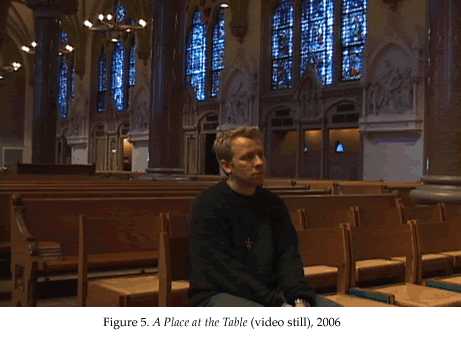 Despite my connections I began to face a great deal of resistance from both the
straight and gay Catholic community. The gay community was afraid they would
face discrimination if they were part of the documentary and the straight
community did not want the issue talked about. Fortunately, I had become friends
with Brother Brian Halderman, a ‘religious’ in The Society of Mary (a sect of
the Roman Catholic Church), who was one of the first openly gay people to enter
religious life in the Catholic Church. He became the largest supporter of “A
Place at the Table.” He put me in contact with many other gay Catholics, over
fifty people in all, of which only seven allowed me to interview them. To gain
more familiarity I began to be an active member of the gay Catholic community. I
volunteered at Catholic booths at queer events, sang in the Catholic choir for
the Sounds of Acceptance benefit, and attended Peace and Justice meetings (a gay
friendly Catholic organization). By doing these activities I not only was able
to meet more gay Catholics but gained firsthand knowledge of the discrimination
gay Catholics have to endure, both from the queer community and within the
Church. This helped me gain the proper perspective for the work... (continue reading) Despite my connections I began to face a great deal of resistance from both the
straight and gay Catholic community. The gay community was afraid they would
face discrimination if they were part of the documentary and the straight
community did not want the issue talked about. Fortunately, I had become friends
with Brother Brian Halderman, a ‘religious’ in The Society of Mary (a sect of
the Roman Catholic Church), who was one of the first openly gay people to enter
religious life in the Catholic Church. He became the largest supporter of “A
Place at the Table.” He put me in contact with many other gay Catholics, over
fifty people in all, of which only seven allowed me to interview them. To gain
more familiarity I began to be an active member of the gay Catholic community. I
volunteered at Catholic booths at queer events, sang in the Catholic choir for
the Sounds of Acceptance benefit, and attended Peace and Justice meetings (a gay
friendly Catholic organization). By doing these activities I not only was able
to meet more gay Catholics but gained firsthand knowledge of the discrimination
gay Catholics have to endure, both from the queer community and within the
Church. This helped me gain the proper perspective for the work... (continue reading)
 
Sean Gyshen Fennell
|
By Sean Gyshen Fennell
Sean Gyshen Fennell is queer artist and activist originally from the Pacific Northwest. He attended Willamette University in Salem, Oregon and recently completed his graduate work at Washington University in St. Louis, Sam Fox School of Design and Visual Arts. Fennell is currently living in Denver, Colorado and teaching at the University of Denver, School of Art. |

|
PREVIEW MP3 RECORDING:
This text will be replaced by the flash music player.
|
|
|
 After I had interviewed several gay Catholics and the leader of Peace and
Justice (Sister Marge O’Gorman), I realized that I had to find someone who could
set the stage of the documentary by laying out the official Church doctrine on
homosexuality. This proved to be a complicated process of dealing with Catholic
bureaucracy from the Archbishop down to the ostensibly heterosexual Father James
Knapp, the leader of Courage (the official Catholic Group for people with
homosexual tendencies). While I was attempting to get an interview from someone
inside the Church about the doctrine, I had to be very careful to not draw too
much attention to some of the other organizations and people I had already been
in contact with. I did not want to cause the gay friendly organizations to be
shut down. Eventually, I was granted an official Archbishop sanctioned interview
with Father Knapp. The interview was tense, his speech was guarded and he
recorded me as I recorded him. After I had interviewed several gay Catholics and the leader of Peace and
Justice (Sister Marge O’Gorman), I realized that I had to find someone who could
set the stage of the documentary by laying out the official Church doctrine on
homosexuality. This proved to be a complicated process of dealing with Catholic
bureaucracy from the Archbishop down to the ostensibly heterosexual Father James
Knapp, the leader of Courage (the official Catholic Group for people with
homosexual tendencies). While I was attempting to get an interview from someone
inside the Church about the doctrine, I had to be very careful to not draw too
much attention to some of the other organizations and people I had already been
in contact with. I did not want to cause the gay friendly organizations to be
shut down. Eventually, I was granted an official Archbishop sanctioned interview
with Father Knapp. The interview was tense, his speech was guarded and he
recorded me as I recorded him.
“A Place at the Table” runs approximately ten minutes and is comprised of
interviews shot in the interviewee’s personal spaces such as, a home or place of
worship. They are linked together with symbolic footage of Catholic imagery,
mostly taken from the Cathedral Basilica of Saint Louis and the Saint Francis
Xavier College Church. This documentary addresses the Church’s doctrine in
contrast to the actual experience of living as a homosexual in the Church.
After working closely with the gay Catholic community, I wanted to return to
working with ideas of gender, experience and the body. I also felt it was time
for me to work more directly from personal experiences.
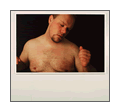  At age 14, I underwent a double mastectomy as a result of gynocomastia, a
disorder in some boys that results in the formation of breasts at puberty. The
surgery left me with large scars across my chest and around my nipples. These
scars represent my own painful experience with non-normative gender. These
photographs attempt to take control back over my body in a way that celebrated
that experience while acknowledging the pain. At age 14, I underwent a double mastectomy as a result of gynocomastia, a
disorder in some boys that results in the formation of breasts at puberty. The
surgery left me with large scars across my chest and around my nipples. These
scars represent my own painful experience with non-normative gender. These
photographs attempt to take control back over my body in a way that celebrated
that experience while acknowledging the pain.
Out of the images I had, I found one that struck me; my eyes were closed, my
expression a mix between ecstasy and pain – my gesture dynamic. I wanted to
highlight the gesture and emotion while emphasizing the scars. I came to the
idea of sewing red thread into the image over the scars to
accentuate the emotional consequences of the
surgery. During the process of sewing I noticed that the gesture in the
photograph was similar to the action I was making. This realization caused me to
connect the thread to my hand in the image. The thread and image seemed to
visually merge into each other.
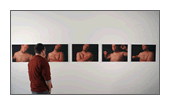  For the final presentation of what came to be known as “Sewing the Façade” I
chose five images, printed them life-size on matte finished paper and sewed into
them with red thread. On some of the images I sewed strictly over the scars from
my surgery and in others I responded less literally to the image. All of the
images are of me from the mid-torso up, on a black background, with my eyes
closed. The thread is sewn into my chest at various locations and connects to my
hands to make it appear as if the image is sewing itself. I left the needle on
the thread dangling outside the frame to further the illusion and to break the
frame of the picture. The use of red thread and the inclusion of the needle is
of particular importance to the work. They are meant to be read beyond the
literal reference of blood and surgery, to be healing yet destructive,
concealing while highlighting, masculine and feminine. These elements get to the
core of what I want “Sewing the Façade” to visually articulate. For the final presentation of what came to be known as “Sewing the Façade” I
chose five images, printed them life-size on matte finished paper and sewed into
them with red thread. On some of the images I sewed strictly over the scars from
my surgery and in others I responded less literally to the image. All of the
images are of me from the mid-torso up, on a black background, with my eyes
closed. The thread is sewn into my chest at various locations and connects to my
hands to make it appear as if the image is sewing itself. I left the needle on
the thread dangling outside the frame to further the illusion and to break the
frame of the picture. The use of red thread and the inclusion of the needle is
of particular importance to the work. They are meant to be read beyond the
literal reference of blood and surgery, to be healing yet destructive,
concealing while highlighting, masculine and feminine. These elements get to the
core of what I want “Sewing the Façade” to visually articulate.
“Sewing the Façade” addresses ideas surrounding the body in relationship to
self-expression, queerness and gender. It celebrates the beauty of the
non-normative while documenting the pain afflicted by the normative ideal.
 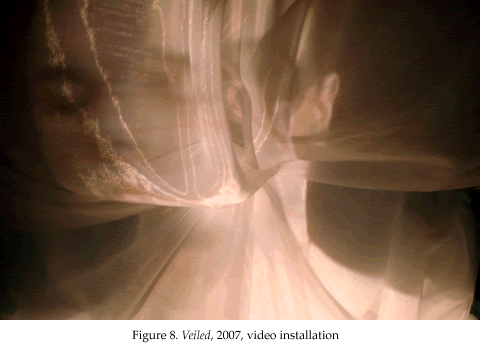 Most recently, I created the video installation “Veiled.” The work consists of
large amounts of various white fabrics suspended in the middle of a dark space
with a video projection coming from inside. The initial view is of a large
circular glowing white satin form. There is a part in the fabric that serves as
an entry revealing the inner part of the installation. Inside there is soft
gathered chiffon. From behind a single sheet of sheer fabric a video of myself
is projected in small scale. Since the fabric is sheer and the projection is
from behind, the flowing fabric lining the structure also has a larger less
sharp version of the video projected on it. The rear projection is also what
gives the exterior fabric a glow, even though no discernable image can be seen
from the outside... (continue reading) Most recently, I created the video installation “Veiled.” The work consists of
large amounts of various white fabrics suspended in the middle of a dark space
with a video projection coming from inside. The initial view is of a large
circular glowing white satin form. There is a part in the fabric that serves as
an entry revealing the inner part of the installation. Inside there is soft
gathered chiffon. From behind a single sheet of sheer fabric a video of myself
is projected in small scale. Since the fabric is sheer and the projection is
from behind, the flowing fabric lining the structure also has a larger less
sharp version of the video projected on it. The rear projection is also what
gives the exterior fabric a glow, even though no discernable image can be seen
from the outside... (continue reading)
 
Sean Gyshen Fennell
|
By Sean Gyshen Fennell
Sean Gyshen Fennell is queer artist and activist originally from the Pacific Northwest. He attended Willamette University in Salem, Oregon and recently completed his graduate work at Washington University in St. Louis, Sam Fox School of Design and Visual Arts. Fennell is currently living in Denver, Colorado and teaching at the University of Denver, School of Art. |

|
PREVIEW MP3 RECORDING:
This text will be replaced by the flash music player.
|
|
|
The video projects an image of me nude from the shoulders up slowly spinning as
thin red threads bind my face and neck. The video begins with a few threads on
my face and over approximately six minutes they form large ribbon-like bands
over my eyes, mouth and neck, at this point the footage reverses and begins to
unbind me; It is meant to be seen as non-linear and perpetual. I chose to edit
the clips with very slow cross-fades in order to maintain the meditative feel of
the work and reduce the loop from two hours to twelve minutes.
To me gender is learned and not innate. The video references gender as a
performance by depicting the nature of the constraints of normative gender with
the slow building of the thread over time to completely deform and constrict my
face and neck. The looping shows how one can never truly escape these
constraints: first they appear invisible or inconsequential, but over time they
will build up until they completely conceal a person.
 While there are several potential reads for the function of the fabric
structure; I am most interested in it as a veil and in reference to
theatricality. The veil is currently a highly debated and controversial topic
with reference to the Islamic tradition of veiling women. To me the veil is an
overt symbol of oppression, a garment that binds and obscures. I hope to tap
into this debate and the possible reads of the veil. I am using the reference of
the veil by literally veiling the image from viewers by projecting the image
through many layers of fabric to make the initial image unreadable but
aesthetically seducing. I then invite the viewers to come inside the satin veil.
Once inside they are then confronted by a crisp and disturbing image of a person
being bound by thread. The harshness of the image is contrasted by the ethereal
nature of the large softer image being projected onto the chiffon lining. This
duality is important as it articulates the duality of what is perceived with
gender and what is experienced. While there are several potential reads for the function of the fabric
structure; I am most interested in it as a veil and in reference to
theatricality. The veil is currently a highly debated and controversial topic
with reference to the Islamic tradition of veiling women. To me the veil is an
overt symbol of oppression, a garment that binds and obscures. I hope to tap
into this debate and the possible reads of the veil. I am using the reference of
the veil by literally veiling the image from viewers by projecting the image
through many layers of fabric to make the initial image unreadable but
aesthetically seducing. I then invite the viewers to come inside the satin veil.
Once inside they are then confronted by a crisp and disturbing image of a person
being bound by thread. The harshness of the image is contrasted by the ethereal
nature of the large softer image being projected onto the chiffon lining. This
duality is important as it articulates the duality of what is perceived with
gender and what is experienced.
The reference of the theater, with the fabric alluding to a curtain, parallels
the concealing of the veil but speaks directly to the idea of gender as a
performance. This is also integral to the work because the clear image is
eventually revealed. In this way the connotations of the veil and the theater,
in reference to gender as performance, combine to make the potential
interpretation of the work more accurate to my intention.
A Foundation for Artistic
Practice: Discussion of Influences
 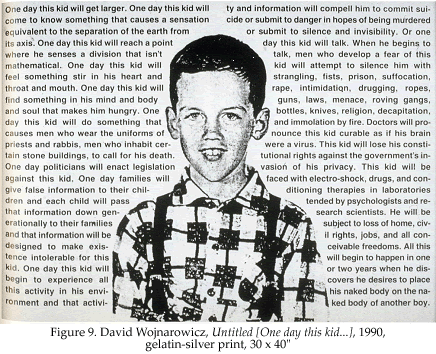 My discovery of David Wojnarowicz was the result of two important moments in my
life: coming out as queer, and making the decision to pursue being an artist. I
immediately became enthralled by his work and pored over it for months. His
writings are coarsely honest and his imagery complex and loaded with meaning.
The works that combined his writing and images became of particular interest to
me. For example “Untitled [One day this kid…]” is full of rage and hope. The
story is moving and the image of the innocent looking boy (a photograph of David
Wojnarowicz as a boy) surrounded by the text work together to produce a powerful
account of his life in a manner that reaches beyond mere autobiography. Above
all I value and carry with me his unapologetically personal approach to art
making. As Dan Cameron states: My discovery of David Wojnarowicz was the result of two important moments in my
life: coming out as queer, and making the decision to pursue being an artist. I
immediately became enthralled by his work and pored over it for months. His
writings are coarsely honest and his imagery complex and loaded with meaning.
The works that combined his writing and images became of particular interest to
me. For example “Untitled [One day this kid…]” is full of rage and hope. The
story is moving and the image of the innocent looking boy (a photograph of David
Wojnarowicz as a boy) surrounded by the text work together to produce a powerful
account of his life in a manner that reaches beyond mere autobiography. Above
all I value and carry with me his unapologetically personal approach to art
making. As Dan Cameron states:
He was a genuine idealist in the sense that he spoke up loudly for causes that
he believed in and never hesitated to make his art a vehicle for his political
convictions. But he was also a visionary artist in the sense that his works were
often triggered by private experiences or dreams, and he was especially fond of
creating links between ecstatic experience and polemical confrontation (Cameron,
3).
Wojnarowicz seemed to give me permission to speak loudly and never hesitate. I
began to create art that explicitly dealt with my personal experiences, often in
an overtly political way. Working this way was an extremely important step for
my work. I still work from personal experiences but have begun to move away from
being as aggressively political and as overtly autobiographical.
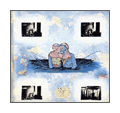  The way I approach materials and object making mirrors that of Wojnarowicz. I do
not focus exclusively on aesthetics or issues and I use a variety of media as a
way to bring new layers of meaning and context to my work (Cameron, 4). However,
visually my work is very different from Wojnarowicz’s. This is especially true
in my more recent work where I have sought to have a very simple and elegant
aesthetic as opposed to Wojnarowicz’s complexly charged and emotionally raw
style. The way I approach materials and object making mirrors that of Wojnarowicz. I do
not focus exclusively on aesthetics or issues and I use a variety of media as a
way to bring new layers of meaning and context to my work (Cameron, 4). However,
visually my work is very different from Wojnarowicz’s. This is especially true
in my more recent work where I have sought to have a very simple and elegant
aesthetic as opposed to Wojnarowicz’s complexly charged and emotionally raw
style.
 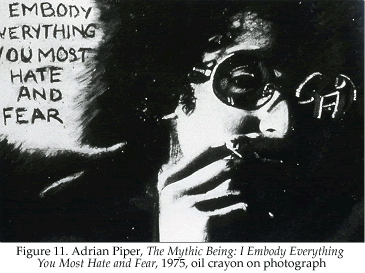 Adrian Piper’s essay “The Joy of Marginality” speaks eloquently about passing as
mainstream, yet being marginal to it, and the perspective this relationship
provides (Piper, 236). I also attempt to utilize this privileged perspective in
my work to comment on the mainstream thought process. Although the source of my
marginality is due to being queer and not my ethnic identity, my awareness and
response corresponds with Piper’s. Adrian Piper’s essay “The Joy of Marginality” speaks eloquently about passing as
mainstream, yet being marginal to it, and the perspective this relationship
provides (Piper, 236). I also attempt to utilize this privileged perspective in
my work to comment on the mainstream thought process. Although the source of my
marginality is due to being queer and not my ethnic identity, my awareness and
response corresponds with Piper’s.
I become
aware of my racial identity when someone brings it to my attention. This
happens, for example, whenever someone makes a racist, sexist, homophobic, or
ethnic slur of any kind. That brand of irrational hostility, no matter where it
is explicitly directed, reminds me of my vulnerability as a black person (Piper,
233).
 This is analogous to how I perceive my sexuality and gender and react to any
statement of bigotry; it makes me feel vulnerable and enraged. My work is in
response to these feelings, as is Piper’s. This perspective affects my work
directly; I use this perspective to channel my experiences in productive ways
and to take back power in order to not be confined (Piper, 234). This is analogous to how I perceive my sexuality and gender and react to any
statement of bigotry; it makes me feel vulnerable and enraged. My work is in
response to these feelings, as is Piper’s. This perspective affects my work
directly; I use this perspective to channel my experiences in productive ways
and to take back power in order to not be confined (Piper, 234).
Beyond Piper’s writings, her interventionist performance based work and how it
functions is of great importance. In “The Mythic Being” she created an alter-ego
(a young black male) and walked around public places asserting this false
identity, reflecting the root of the discrimination she feels as a black female.
This speaks not only about racial discrimination, but can be read as showing
gender as performance. It is also of interest to my working method in that she
photographs these performances as documentation of the event and then through an
additive process uses that documentation to make an art object. Much of my work
is based in performance, and the photographs of the event are altered. These
alterations, such as the adding of thread to “Sewing the Façade,” turn the
documentation into autonomous art object... (continue reading)
 
Sean Gyshen Fennell
|
By Sean Gyshen Fennell
Sean Gyshen Fennell is queer artist and activist originally from the Pacific Northwest. He attended Willamette University in Salem, Oregon and recently completed his graduate work at Washington University in St. Louis, Sam Fox School of Design and Visual Arts. Fennell is currently living in Denver, Colorado and teaching at the University of Denver, School of Art. |

|
PREVIEW MP3 RECORDING:
This text will be replaced by the flash music player.
|
|
The purpose of Piper’s work makes viewers aware of their own racism. She
constructs relationships with the viewers to highlight their xenophobia. While
my work is not as immediate and more specifically addresses ideas surrounding
sexuality and sex, our perspective and intent is similar.
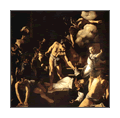  While my ideologies and some working methods parallel both Wojnarowicz and
Piper, aesthetically there are few similarities. Visually I draw from such
artists as Caravaggio and Mapplethorpe, both of whom are used as examples in
Dave Hickey’s The Invisible Dragon: Four Essays on Beauty where he talks
about the idea of transgressive beauty and its “subversive potential” (Hickey,
13). While my ideologies and some working methods parallel both Wojnarowicz and
Piper, aesthetically there are few similarities. Visually I draw from such
artists as Caravaggio and Mapplethorpe, both of whom are used as examples in
Dave Hickey’s The Invisible Dragon: Four Essays on Beauty where he talks
about the idea of transgressive beauty and its “subversive potential” (Hickey,
13).
In my work I look to the gestures, tenebrism, and imagery of Caravaggio. Today
he is seen as a maker of beautiful paintings. However, Hickey argues that during
the time of Caravaggio his works were seen as political due to their subject
matter surrounding the religious debate of intercession.
[W]e must ask
ourselves if Caravaggio’s ‘realism’ would have been so trenchant of his formal
accomplishments so delicately spectacular, had his contemporary political
agenda, under the critical pressure of a rival Church, not seemed so urgent?
(Hickey, 18)
He argues that Caravaggio used aesthetics to lull his viewers into contending
with its subject matter. I draw from this baroque aesthetic in my lighting and
color palette. I want my viewers to be visually seduced by the work and
therefore made to contend with the more socio-political content of the work.
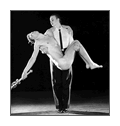  Robert Mapplethorpe used beauty’s inherent visual draw as a means to communicate
ideas of sexuality that run contrary to the mainstream. Hickey argues that the
subject matter alone was not what caused conservative activists of the time to
react so violently, but that he depicted the acts as beautiful. Robert Mapplethorpe used beauty’s inherent visual draw as a means to communicate
ideas of sexuality that run contrary to the mainstream. Hickey argues that the
subject matter alone was not what caused conservative activists of the time to
react so violently, but that he depicted the acts as beautiful.
It was not that men
were making it then, but that Robert [Mapplethorpe] was ‘making it beautiful.’
More precisely, he was appropriating a Baroque vernacular of beauty that
predated and, clearly, outperformed the puritanical canon of visual appeal
espoused by the therapeutic institution (Hickey, 22).
If one represents marginal experiences or people in an unappealing or ugly way
then there is nothing being said that runs contrary to mainstream thought. By
using beauty while photographing queer subject matter one subverts the
mainstream gaze simply by portraying what is widely seen as negative in a
positive light.
Another major aspect to my work is how queerness is manufactured. Michael Warner
claims:
The closet is better understood as the culture’s problem, not the individual’s …
It is experienced by lesbians and gay men as a private, individual problem of
shame and deception. But it is produced by the heteronormative assumptions of
everyday talk. It feels private. But, in an important sense it is publicly
constructed (Warner, 52).
 Warner touches upon several main preoccupations in my work. I aim to explore how
queerness is mediated and defined by the heteronormative culture, and to reveal
those definitions and rearticulate them from a queer perspective. I see the body
as the site of mediation between this heteronormative culture and the internal
psyche of the individual. The body, like Warner’s idea of the closet, is
experienced as an individual place of shame and deception, but is ultimately
publicly constructed. In my work, I strive to depict the internal experiences
of heteronormativity on queer bodies. The depiction of this struggle is an
attempt to regain power over the effects of heteronormativity. Warner touches upon several main preoccupations in my work. I aim to explore how
queerness is mediated and defined by the heteronormative culture, and to reveal
those definitions and rearticulate them from a queer perspective. I see the body
as the site of mediation between this heteronormative culture and the internal
psyche of the individual. The body, like Warner’s idea of the closet, is
experienced as an individual place of shame and deception, but is ultimately
publicly constructed. In my work, I strive to depict the internal experiences
of heteronormativity on queer bodies. The depiction of this struggle is an
attempt to regain power over the effects of heteronormativity.
Through this discussion I have put myself in dialogue with some of the key
artists, cultural critics and art theorists that have informed my art making.
From them I have gained a great deal; from Laqueur an understanding of the true
nature of gender, from Wojnarowicz an unapologetically personal approach, from
Piper an embracement of the perspective and experience of being Other, from
Hickey an understanding of the role and power of subversive beauty, from
Caravaggio and Mapplethorpe examples of how to create images of polemical
beauty, from Warner a critical understanding of heteronormativity. In this sense
my work can be considered a branch of the Politics Identity Art Movement. While
I draw from these ideologies, I am moving away from an overtly political stance
to work with an emphasis on cultural commentary in an attempt to make visible
the mechanisms by which people’s experiences are mediated and how they manifest.
 Thus far, my work has been engaged with a critical yet celebratory investigation
of queerness, with a particular emphasis on gender formation and experience.
For me to achieve this, it is crucial that I begin by working from my own
personal experiences in an attempt to transcend the autobiography, without
discounting it. To effectively communicate my ideas I strive for visually
seductive work that contains cultural commentary. Thus far, my work has been engaged with a critical yet celebratory investigation
of queerness, with a particular emphasis on gender formation and experience.
For me to achieve this, it is crucial that I begin by working from my own
personal experiences in an attempt to transcend the autobiography, without
discounting it. To effectively communicate my ideas I strive for visually
seductive work that contains cultural commentary.
I am still fascinated by, and will continue to work with, the mechanisms that
inform gender. However, I have been investigating feminine aspects and
experiences of queer gender. While this is an important aspect to my work, I
have come to the realization that masculinity has an analogous relationship to
the invisible mechanisms that cause systems of oppression. I plan to use this
perspective and to begin investigating masculinity and how it functions in
relationship to queerness... (continue to references)
 
Sean Gyshen Fennell
|
By Sean Gyshen Fennell
Sean Gyshen Fennell is queer artist and activist originally from the Pacific Northwest. He attended Willamette University in Salem, Oregon and recently completed his graduate work at Washington University in St. Louis, Sam Fox School of Design and Visual Arts. Fennell is currently living in Denver, Colorado and teaching at the University of Denver, School of Art. |

|
PREVIEW MP3 RECORDING:
This text will be replaced by the flash music player.
|
|
|
Works Cited
Cameron,
Dan, John Carlin, C. Carr, and Mysoon Rizk. Fever: the Art of David
Wojnarowicz. New York: New Museum Books, 1999. 3-43
Hickey,
Dave. The Invisible Dragon: Four Essays on Beauty. Los Angeles:
Art Issues P, 1993. 11-24.
Laqueur, Thomas. Making Sex: Body and
Gender From the Greeks to Freud. Cambridge, Massachusetts, and
London, England: Harvard UP, 1992.
Piper,
Adrian. Out of Order, Out of Sight. Vol. 1. Cambridge,
Massachusetts, and London, England: The MIT P, 1996. 233-237
Warner,
Michael. Publics and Counterpublics. New York: Zone Books, 2002.
Continue to "Appendix 1."
 
Sean Gyshen Fennell
|
By Sean Gyshen Fennell
Sean Gyshen Fennell is queer artist and activist originally from the Pacific Northwest. He attended Willamette University in Salem, Oregon and recently completed his graduate work at Washington University in St. Louis, Sam Fox School of Design and Visual Arts. Fennell is currently living in Denver, Colorado and teaching at the University of Denver, School of Art. |

|
PREVIEW MP3 RECORDING:
This text will be replaced by the flash music player.
|
|
|
Appendix 1, "Interview Transcript"
Las
Larson: Sean Gyshen Fennell is an artist at Willamette University.
How are you doing Sean?
Sean
Gyshen: Doing pretty well Lars, how are you?
LL:
Glad to have you on the program but I’m not real happy about that
artwork. I mean it’s a private university you can put what you want on
the walls. I’ve had a lot of people trying to figure out what this
artwork means. These naked figures of people who appear to be in
embraces that would indicate they are homosexuals and then torn up pages
of something at the bottom of the photos. Why don’t you tell us what
it’s all about.
SG:
I’d love to. First of all the goal of the icon project is to yield art
that investigates societal constructs and visually stimulates the viewer
and to facilitate discussion. Which is why I am very happy to be on your
show because that is what the work is intended to do. The text that is
in the background is actually some of the measures that were passed,
excluding gay marriage, Measure 36 and the smaller icons that are below
are the Patron saints such as St. Anthony of Padua or St. Patrick who
are the patron saints of the oppressed people and excluded people. And
the figures in fact, in the icons are homosexuals and its trying to draw
lines between these and investigate the current political and religious
climate.
LL:
Does one of those figures work for Kate Brown, the senator?
SG:
I am not familiar with that.
LL:
Sure, you don’t know the people you took naked pictures of?
SG:
I know them very well but I don’t know what they are doing now. I
actually moved to St. Louis. I am attending graduate school.
LL:
OK So here’s the concern I have. Why would you show a ballot measure
passed by Oregonians overwhelmingly torn up at the bottom of the picture
like that?
SG:
Well, it is actually not torn up. It’s in its completion there is gold
leafing over the entire image which I guess gives it an appearance of
being torn.
LL:
So it’s not really torn up?
SG:
No, it is not torn up. It is in its completion.
LL:
It’s in completion?
SG:
All the text is there it is just that some of it is obscured with gold
leaf.
LL:
Okay, So it wasn’t intended to look torn up.
SG:
No
LL:
Okay. Now the figures appear to be posed in a way that I thought it
looked like icons like you’d seen in Russian icon, the little kind of
circles around the head and a little gold leaf.
SG:
Exactly
LL:
So you are depicting homosexual figures in photos as saints.
SG:
I am referencing Byzantine Icons and religion through those forms. I do
not consider the objects to be venerated in any way. I am merely using
visual language.
LL:
No, now what’s the visual language when you depict homosexual figures in
a photo as saints?
SG:
I am referencing the saint figures as well as drawing attention the fact
there are saints within the religion such as St. Anthony of Padua for
oppressed people yet the religion in of itself is oppressing individuals
and saints themselves have been martyred. And...
LL:
(Interrupts) How is religion oppressing homosexual people?
SG:
Well, I mean it’s pretty clear within the legislation
and in
your show that all Christians should be offended by images like the ones
I made.....
LL:
Well no no, I am bothered by images if they if they if they are comments
on religion by taking homosexual figures and portraying them as saints.
I don’t think any religion on earth makes people saints by their
personal behavior or homosexual behavior. And I don’t know how it is
you think religion oppresses people with regard to their sexuality. You
have a choice as to which religion you participate in. Tell me which
religion oppresses homosexual people.
SG:
Well right now Catholicism especially the Vatican is saying homosexuals
cannot be ordained. I mean for example...
LL:
Well well but that’s the rules of their group. If you are a homosexual
and you want to be ordained, you go to a different church.
SG:
Well are you saying homosexuals should not be able to be Catholic?
LL:
Well that’s what the Catholic Church has decided. Does a church have the
right to set the standards for its religion?
SG:
I believe...........
LL:
I mean for example. If... I like I like to drink whiskey on occasion.
I try to do it in moderation and I try to do it only on the weekends
with friends and when I am not going to drive. But if I wanted to
join the Mormon Church Sean, I can guaran’ damn tee you that the Mormons
are not going to let me in as a whiskey drinker.If I say, well you ought
to change your rules and let whiskey drinkers into the Mormon Church
they’d say Lars, one of the tenants of our religion is that you don’t
drink booze. So why would a booze drinker want to join the Mormon
Church? Why would a homosexual want to become ordained as a member of a
church that doesn’t... you know that does not believe that homosexuals
should become priests?
SG:
Well drinking whiskey Lars is a choice where I do not believe
homosexuality is a choice and there are these people who have been
brought up as Christians....
LL:
No but joining a church is a choice, becoming a religion is a choice.
Can we agree on that?
SG:
Joining a religion is a choice..
LL:
I could choose to become a Catholic tomorrow, I could choose to to
convert to Judaism tomorrow so but why would I want to join a church
that doesn’t respect the way I conduct my life?
SG:
Well possibly that was the church you were brought up in and that is the
community you feel comfortable in and perhaps that is the faith you
actually believe in yet it discriminates against you and you should
still have the choice to join that religion, I believe.
LL:
Do you think the people should be offended by your art work?
SG:
If people are offended by my artwork I think that is fine. The work in
of it’s self is there to facilitate discussion and hopefully draw
connections and get people to start thinking about that there are
certain societal constructs that prohibit people from doing things
and...
LL:
You’re trying to get people to think differently, right?
SG:
I am trying to bring a different prospective to these issues that have
intertwined through out history. I mean homosexuality in the church and
art is nothing new. It has been there for an extremely long time.
LL:
Good point. Sean I’m up against a clock but I appreciate your time
sir. Thank you very much.
SG:
Thank you very much.
|
|
Navigate:
1 | 2 | 3 | 4 | 5 | 6
|
| | | | |
|




3 COMMENTS ON THIS ESSAY:
I love your art, especially the iconoclast images. Can I find them online elsewhere?
This type of art also highlights the similarities between devotion to religion and devotion to your partner, which I think is closer than a lot of people think.
simply stunning...:)
We are running a short feature of your art on www.redlimemagazine.com until Feb 4th
Your work is beautiful!